Everything you need to know about growing hydrangeas
Growing hydrangeas is a no-brainer if you want a garden with year-round interest.
They flower from mid-summer until the end of the year.
And in autumn, some hydrangeas have brilliant red and gold leaf colour.
Then the sculptural shapes of their flowers, dried to papery elegance, make wonderful outlines in the frost over winter.
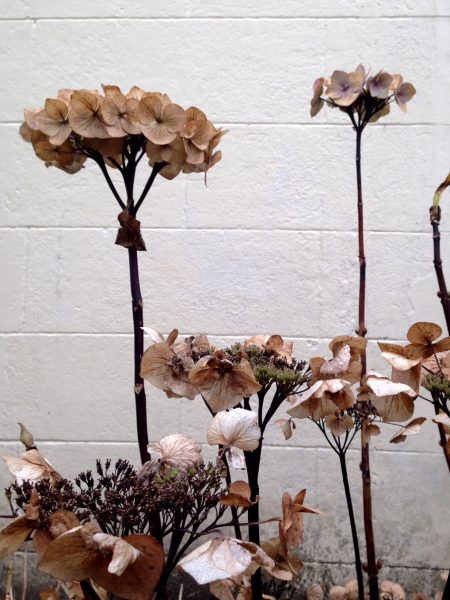
Hydrangea heads make wonderful sculptural shapes in winter.
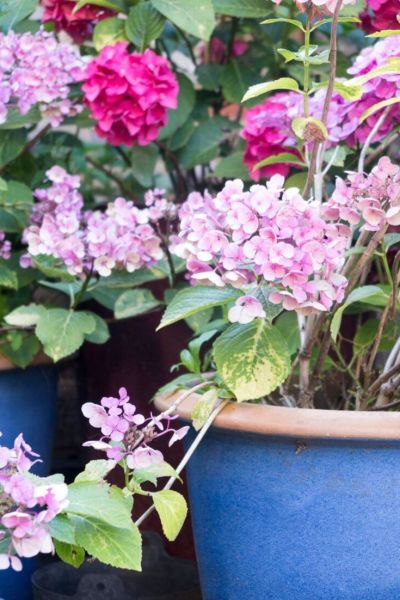
And hydrangeas are brilliant in pots!
When I started being interested in hydrangeas – around two years ago – they had a somewhat suburban reputation. As do many shrubs.
But as I update this post in 2022, there’s no doubt that hydrangeas are ‘back’! They are such easy plants and offer so much for the garden.
I visited Signature Hydrangeas, specialist growers of hydrangeas to talk to hydrangea expert, Roger Butler, about the basics of choosing and growing hydrangeas. If you’d rather watch a video than read a post, you can watch Growing Hydrangeas on YouTube here.
The different hydrangea types – start with macrophylla…
Hydrangeas make much more sense once you know the most common types. And that’s important because there are basically two very different kinds of pruning, depending on what type of hydrangea you have.
But even if you haven’t kept the label, it’s relatively easy to tell which type of hydrangea is which by looking at either the flower shape or the leaf shape.
There is a minimal pruning method that will work with both kinds of hydrangea, although your plants will look better in the long run if you find out how to prune them correctly for their type. But see the Really Easy Guide to Pruning Hydrangeas if you feel worried about it all.
The best known are the macrophyllas, which divide into mop heads and lace caps.
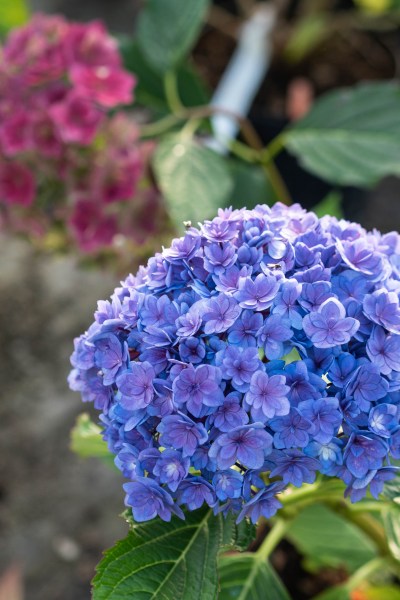
This is a mop head hydrangea – it has a round mop head.
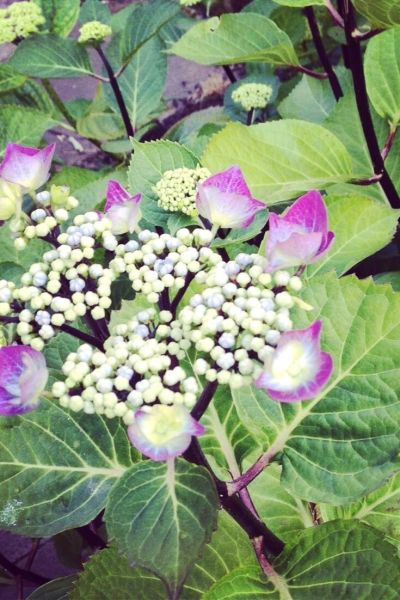
Lacecap hydrangeas have little buds in the centre and open flowers around the edge. An unknown hydrangea in a friend’s garden.
The fashionable Hydrangeas arborescens and paniculata…
The ‘arborescens’ hydrangeas are known as ‘wild hydrangeas’ or ‘smooth hydrangeas’ in the US.
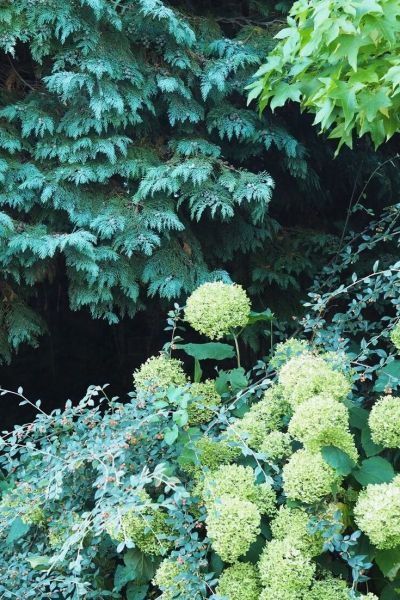
The pom-pom heads of Hydrangea arborescens ‘Annabelle’ are snowy white in July and turn to green by September.
Even if you have never considered growing hydrangeas, you will probably have admired the white puffs of Hydrangea arborescens ‘Annabelle’ in smart gardens over the last ten years.
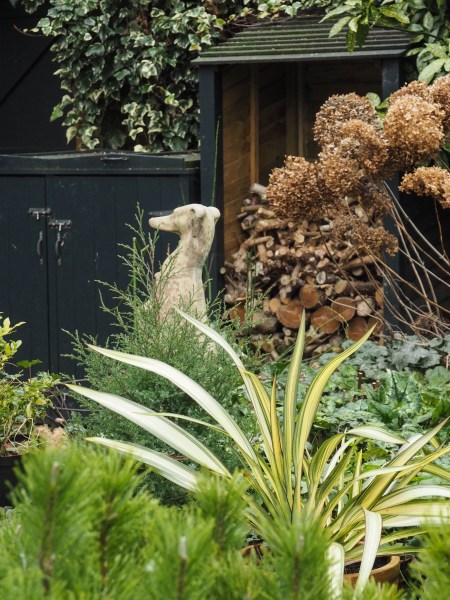
Hydrangea arborescens ‘Annabelle’ in the winter garden. Its brown flower heads remain until March.
Hydrangea paniculata has cone-shaped flowers. The fastest-growing hydrangea in popularity is now the paniculata type, according to Roger Butler. ‘We’ve consistently sold more paniculatas over the last few years than any other hydrangea.’
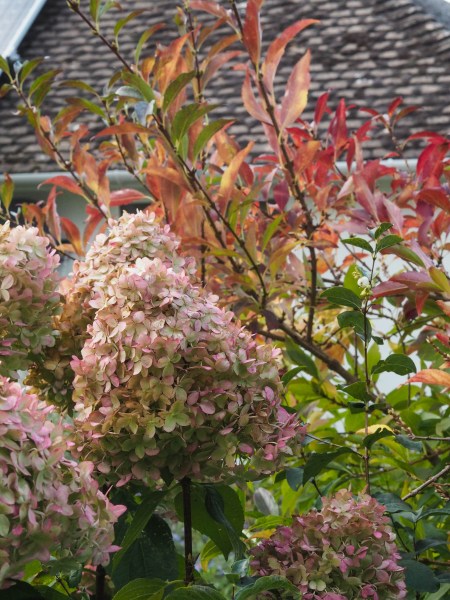
Paniculata hydrangeas in the garden of BBC Gardeners’ World presenter Mark Lane. This is Hydrangea paniculata ‘Vanilla Fraise’
Top garden designer Philippa O’Brien agrees, telling an audience of garden designers that Hydrangea paniculatas are on trend.
If you’re not sure whether you love or hate hydrangeas, here are some of the hydrangea myths dispelled.
And oak leafed hydrangeas…
Hydrangea quercifolia literally means oak-leafed hydrangea. No further explanation needed.
Oak leafed hydrangeas are stylish, and they’re also even more easy-going than most hydrangeas. They’ll put up with dry or cold conditions better than the other hydrangeas.
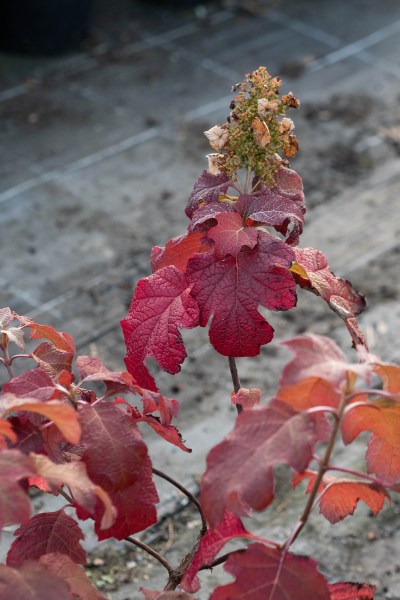
Oak leafed hydrangeas have oak-shaped leaves which change colour in the autumn so they are a great addition to the autumn garden. This is Hydrangea quercifolia ‘Burgundy’ at Signature Hydrangeas.
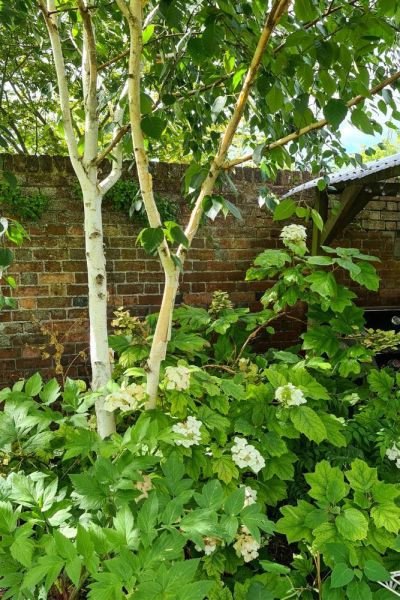
An oak leaf hydrangea (Hydrangea quercifolia ‘Snow Queen’) in my garden. It thrives in the shade of this silver birch, and has been the easiest hydrangea I’ve grown. Some of my other hydrangeas droop in dry periods and need to be watered but even in the hot, dry summer of 2022, I didn’t have to water this one. (It was a close call, though!) This has glorious autumn colour.
Growing hydrangeas for their colour
People are more confused about hydrangea colours than anything, according to Roger. ‘The macrophyllas change colour according to the pH of the soil. Hydrangeas on very acid soil will be blue, but the same hydrangea will be pink if it’s grown on alkaline soil. So people buy a blue hydrangea, plant it in their garden and then it comes up pink.’
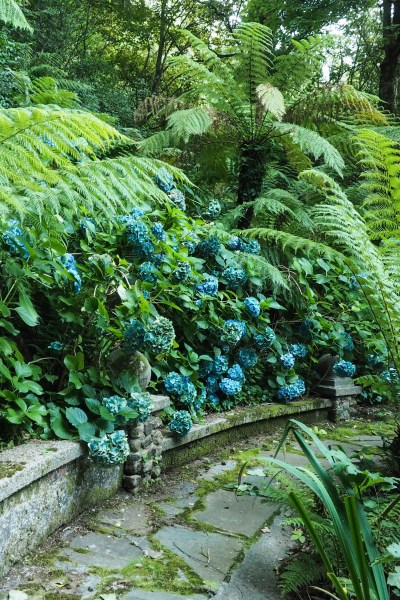
These hydrangeas would be pink if they were grown in alkaline soil. This pretty woodland garden also features in 7 Garden Design Ideas from Four Private Gardens.
If you don’t have acid soil, but want blue hydrangeas you can keep it in a pot and treat the soil with a specialist hydrangea feed, such as Westland Hydrangea Plant Feed. Note: links to Amazon are affiliate, see disclosure.
How do you choose hydrangeas?
If you’re thinking of growing hydrangeas, Roger Butler advises you to start by thinking about your site and soil. ‘If you’re planting hydrangeas in a sunny spot, you should choose paniculatas or arborescens varieties.’
‘And if you’ve got light to heavy shade or woodland conditions, the macrophyllas are the best bet. The flowers of macrophyllas will burn in full sun, so they do need some shade.’
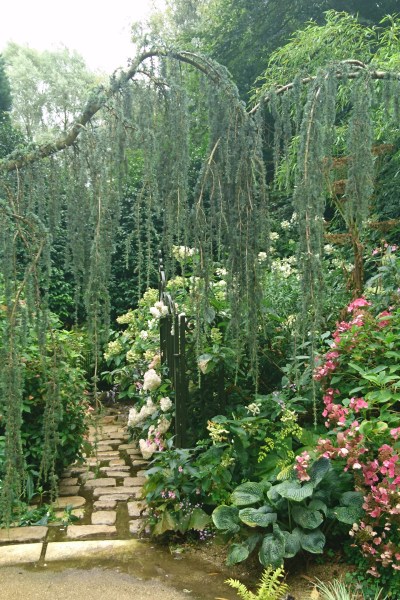
A selection of hydrangeas in the beautiful wooded garden at L’Agapanthe in Northern France. Hydrangeas were originally a woodland species, so they’re ideal in shady spots.
When you should plant hydrangeas?
‘You can plant hydrangeas at virtually any time of year,’ says Roger. ‘But if you plant them in the summer, keep them well watered in dry weather.’
Which plants grow well with hydrangeas?
Roger thinks that hydrangeas work best on their own. ‘They make a dramatic statement in blocks or rows. And macrophyllas are quite dense plants so you wouldn’t want to plant something that needed a lot of sun beside it.’
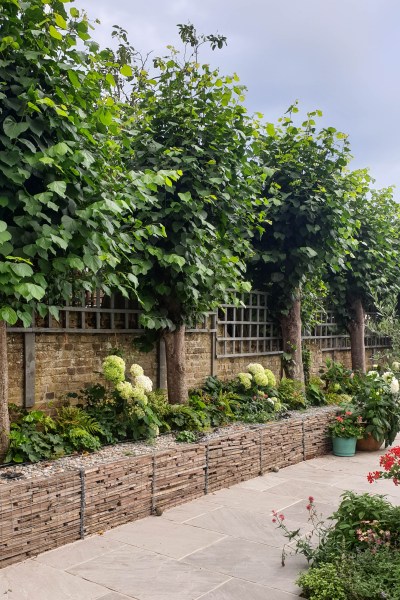
Hydrangea arborescens ‘Annabelle’ in Jane Beedle’s garden. The hydrangeas are the only flowers along this side of the garden, and she has underplanted with smaller, shade-loving plants such as ferns.
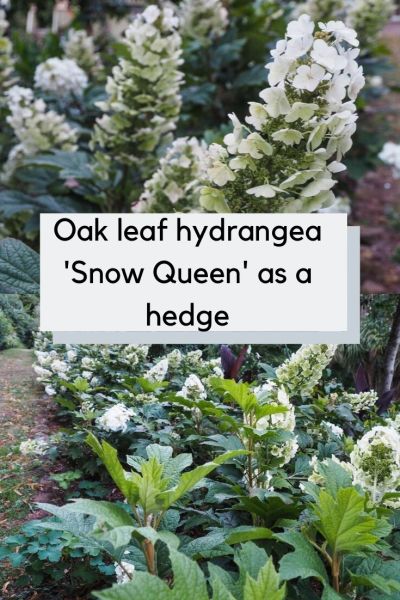
Hydrangea quercifolia ‘Snow Queen’ used as a hedge in an Australian garden. You can see more of this garden in 7 Garden Design Secrets of Four Private Gardens.
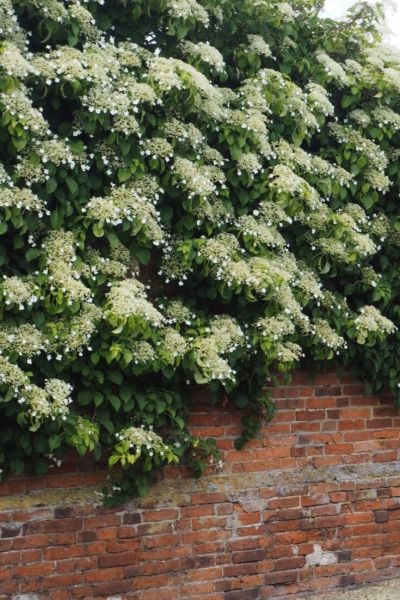
A clump of climbing hydrangeas spilling over a wall in the seaside town of Southwold. Hydrangeas work well in a coastal or windy garden.
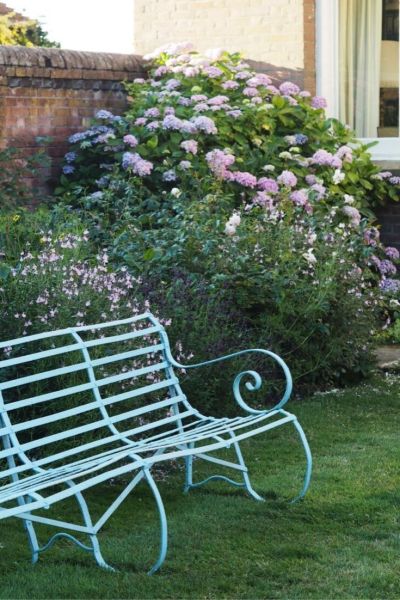
A clump of hydrangeas at the end of a mixed border at Doddington Place Gardens. It has plenty of space and because it’s at the end, it doesn’t shade the plants beside it.
Can you move hydrangeas?
If you think you’ve planted your hydrangea in the wrong place, you can move it, says Roger. ‘The best time to move hydrangeas is the end of October or early November. Get it back into the ground as soon as you can.’
Growing hydrangeas in pots?
Hydrangeas grow very well in pots, says Roger. ‘There’s an increasing number of hydrangeas now sold as patio or indoor plants.’
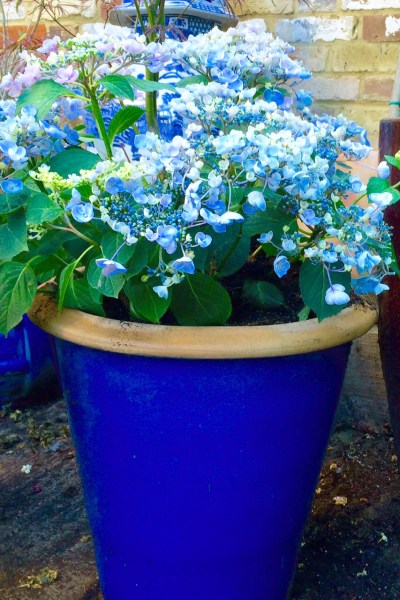
Unknown hydrangea in my friend Emma’s garden. Most hydrangeas do well in pots.
If you buy or are given a hydrangea in a pot, with lots of beautiful blooms, it may have been treated to dwarf its growth and maximise its blooms. So this can mean that if you then plant it out in the garden, it will grow very differently next year.
So if you’re growing hydrangeas for the garden, it’s probably best to buy them from a hydrangea specialist or nursery that grows them for planting in the garden. You can also then discuss what your growing conditions are with someone who will know which hydrangeas will be best for your site.
And you can be reasonably sure that the hydrangea you buy will continue to grow like that and look like that over the next few years.
Hydrangeas make easy, low maintenance plants for pots.
How to prune hydrangeas
If you’re growing hydrangeas, you need to know which type you’ve got in order to prune them.
The macrophyllas (the mop heads and the lacecaps) and the oak-leafed hydrangeas need light pruning. Roger advises you to snip off the dead flower heads in March, taking off the top pair of leaves. You should cut down to the first fat bud you see. That’s next summer’s flower.
There are other hydrangea varieties, such as Hydrangea serrata and Hydrangea aspera, which are pruned lightly as for Hydrangea macrophylla.
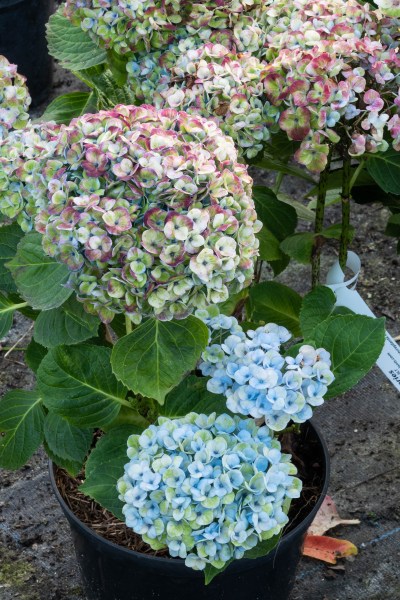
Hydrangea macrophylla ‘Magical Revolution’ from Signature Hydrangeas starts off blue (in acid soil) and gradually changes to pink as it ages. Macrophyllas need light pruning – just snip off the flowers and one pair of leaves.
If you cut macrophyllas and oak leafed hydrangeas down too far, you’ll lose the flowers. However, you may cut out whole stems if you want to thin the plant or improve its shape.
However, the paniculatas and the arborescens need hard pruning. Roger says you should snip them back to two buds above the ground in February or early March.
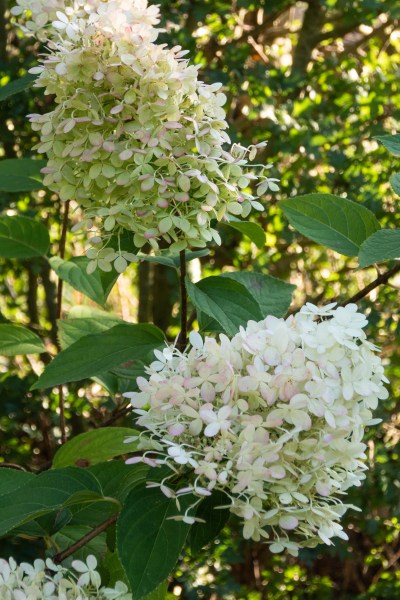
The cone-shaped flowers of Hydrangea paniculata. These, along with the Hydrangea arborescens, need hard pruning down to two buds from the ground.
What about hydrangeas and pests?
Deer and rabbits don’t like hydrangeas because the leaves are mildly toxic, according to Roger. However, some deer aren’t too fussy!
He says there are some problems with slug and snail damage. But at Signature Hydrangeas, they manage these with natural solutions (such as nematodes) and by gardening in a wildlife-friendly way so that the birds, frogs and hedgehogs help keep slugs and snails under control.
Personally, I’ve never found any slug or snail damage on my hydrangeas, but I do have a lot of birds in the garden. And I grow dahlias, which presumably are tastier to the slugs.
Do you need to fertilise hydrangeas?
Roger says that hydrangeas are heavy feeders. He feeds them once in the spring with Osmocote (he also recommends Blood, Fish & Bone), and again around mid-summer.
I don’t think I’ve ever fed my hydrangeas. That’s one for the to-do list.
Note: Links to Amazon are affiliate, see disclosure. As an Amazon Associate I earn from qualifying purchases. Other links are not affiliate.
Why isn’t my hydrangea flowering?
The main cause of hydrangeas not flowering is that they’ve been pruned wrong, says Roger. The flower buds on macrophyllas are at the tops of the stems, so if you prune them back too far, you will lose the flowers.
Why is my hydrangea wilting?
Hydrangeas in pots often wilt, either because they’re short of water. Or they may be sitting in water, says Roger. ‘So if your hydrangea is dry, give it a good soaking, but if it’s sitting in water, make sure it drains off,’ he says.
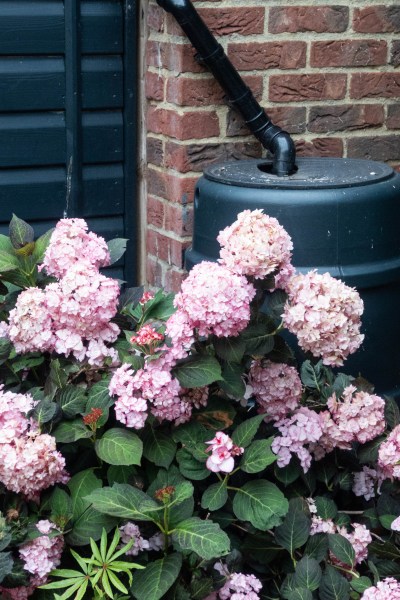
This is Hydrangea macrophylla ‘Miss Saori’. It’s lived in this pot for three years now. I feed it regularly, but sometimes it wilts because it gets too dry. However it always cheers up as soon as it is watered.
More about growing hydrangeas in this video:
You can see more hydrangeas and watch the interview with Roger here:
More glorious late season flowers
Other brilliant flowers for the late season garden include dahlias, salvias and chrysanthemums. Find out everything you need to know about growing dahlias here, and our tips from the UK’s top salvia growing expert here.
Many people think chrysanthemums are difficult to grow or that they don’t like them. In fact, hardy chrysanthemums can be stunning and are as easy as any other plant in your border. To find out how dazzling they can be in your garden, see Dan Cooper’s chrysanthemum growing tips here.
Shop my favourite gardening books, tools and products
I’m often asked for recommendation of good gardening books, tools, gloves and other accessories, so I’ve put together the products I use on the Middlesized Garden Amazon store. For example, there’s a list of the basic gardening tools you need, including the brands I’ve found good.
And there’s also a list of other necessaries, such as good kneelers or knee pads, a source of biodegradable pots and my favourite gardening gloves in the list of gardening essentials.
As I said previously in this post, as an Amazon Associate I earn from qualifying purchases. But it doesn’t affect the price you pay. Other links are not affiliate.
Pin to remember tips for growing hydrangeas
And do join us for more garden tips, ideas and inspiration – you can sign up here.
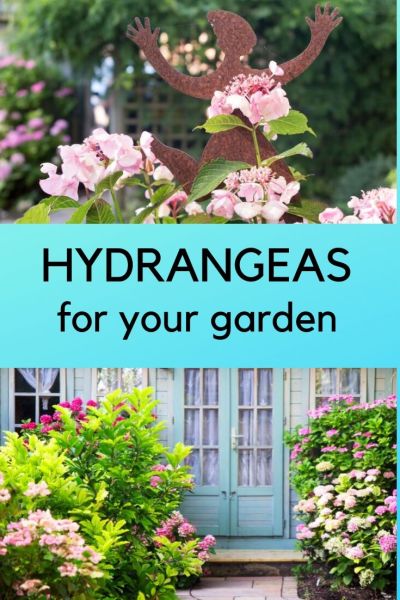

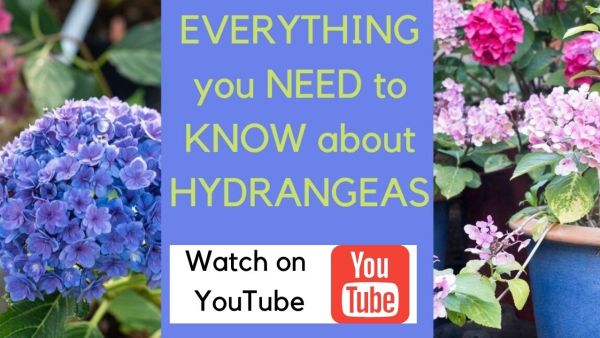























Hello, I have a lace-cap hydrangea that flowers beautifully every year but the crown is now twice the size of the pot. Rather than moving it into another pot, which would be expensive to buy in a suitable large size, I was hoping to be able to replant it in the garden. However, I live on chalk so am worried that it will be too alkaline (I have tested the soil and its pH8) and so the plant won’t thrive. Should I just leave it root bound in its current pot and feed and water it well?
It’s hard to give a definitive answer – so much about gardening is trial and error, but if you’d like to see it in the garden, I’d suggest planting it out but feeding it – you can buy specialist hydrangea feed – over the summer months. You might also consider root pruning – taking it out of the pot and reducing the size of the roots, then replacing it with fresh soil. I haven’t personally done this with hydrangeas so it would be an experiment but many plants do benefit from root pruning. And while it is flowering happily in the pot, however rootbound, it’s probably fine to leave there, with your feeding and watering regime. I know many hydrangeas that have been in pots for years and which seem fine.
My hydrangea were planted by a professional landscaper as part of an overall design but to date, they have never really flowered properly and last year I didn’t get one flower on any of them, and I have quite a few. They look healthy with lots of leaves but no flowers. They’re a mixture of varieties. I have not pruned them for the last couple of years for fear of losing flower buds. We have had tree years of late frosts here on the west of Ireland. Is that the reason for no flowers? Thankyou for you interest in this inquiry. I watched Roger Butler in Gardener’s world and that prompted me to write in. Thankyou
I think it’s possible that they’re poor quality plants – you should go back to the landscaper. But also there may not be enough nitrogen in the soil, so adding something like blood, fish & bone (a powdered fertiliser) or a good all-purpose fertiliser should help. It’s also possible that they just want to get established, although they should be flowering by now. I hope some of that helps.
When can I move my hydrangea seemannii from a container to the ground? It was newly purchased last Autumn and placed in a container. It wilted and had some leaf scorch with the severe frost. It has now started to grow quite well but wilts very easily in strong sun. I want to move it to a border to grow up a shadier wall. Please advise
You can plant it at any time, but if the weather is hot or dry, make sure you keep it well watered for the first few months.
Hi there we planted hydrangeas in pots at the back of the house and they were growing amazingly, then we decided to plant them in the front garden and after losing all the flowers and leaves we were told by a friend we needed to prune them as they looked like twigs so they can go on to grow again sadly this year they look like twigs still with a tiny amount of small leaves and that’s it. I am heartbroken as they were such healthy plants in the pots and I’d like to encourage them to grow again. Also we were told to just plant them and they would be fine straight into the ground and now I’m thinking would it now be better if we took them out mixed compost with the ground mud and then replanted them as they grew into lovely plants whilst in the large planters. Please help as I really Love these plants
Debbie
I think it might be best just to leave them for a while, if you can bear it. When plants are moved, it takes them a bit of time to re-establish, so your hydrangeas may just be thinking about growing. And digging them up again will take them back to square one. Just make sure they’re properly watered (if it doesn’t rain, give them a good soaking around the roots around once a week). Add an all-purpose shrub fertiliser, according to the instructions on the packet, and don’t prune for a year to give the flowers a chance to re-grow. Sometimes plants in pots have been ‘forced’ to flower at different times, so it can take a year or two for them to re-establish a natural life cycle once the first year is over.
Good luck, and I hope that helps, with best wishes, Alexandra
Hi. I have potted hydrangeas that flower every year. My husband has decided to ‘pop some flowers around the base’ in each pot and now the hydrangeas are not growing! Has he killed them? Any advice would be greatly appreciated.
It’s possible that the plants all need some fertiliser. Adding more plants won’t kill the hydrangeas, but the more plants you have in one pot, the more you need to feed and water the pot. Use an all purpose general fertilise.
Just a warning, if you have deer in your area, they WILL eat hydrangeas. I have two that will not bloom because the deer “prune” them at the wrong time.
Ah, yes, since this was published a few people have mentioned that deer will eat hydrangeas, thank you.
When we moved into our current house we inherited two enormous lipstick pink mopheads which had completely outgrown their space. I have to admit, they weren’t my favourite plants. With nothing to lose we shifted them, not an easy task, to a less visible location on the woodland edge. Miracle of miracles, not only did they thrive but every year since then they’ve become progressively more blue. This year they finally made it.. true blue! They can stay now.
Great that you moved them. It’s funny how different the soil can be in different parts of a garden – I have a friend with alkaline soil who has a strip of acid soil at the top of her garden so she can grow hydrangeas.
Perfect timing. I’ve just bought hydrangea paniculata Pinky Winky so now I know how to care for it properly
Love your blog and look forward to many more good reads
Thank you so much. I was at a nursery a few years ago when the company launched Pinky Winky and one journalist asked ‘Does it go Bluey Wooey in acid soil?’ Of course, now we all know that paniculatas don’t change colour…but we did laugh.
The photo identified as lacecap hydrangeas falling over a wall is H. petiolaris, the climbing hydrangea.
So it is! Wasn’t wearing my glasses when I peered at it. Thank you.